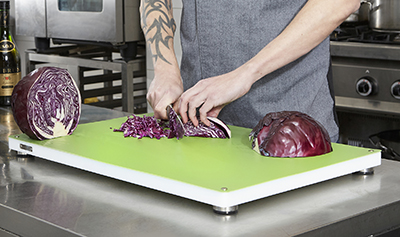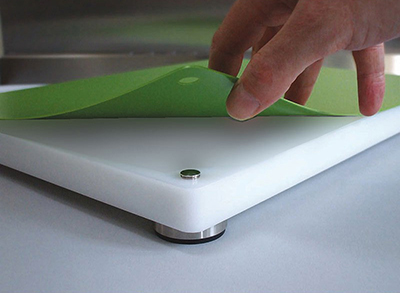April 14, 2021 | PROFBOARD
Kitchen Showdown: Wood vs Plastic Cutting Boards

A kitchen essential, cutting boards come in many shapes, sizes, types and price points. The most common distinction? Wood vs. plastic. It’s a debate that goes into the durability, cleanliness, and presentation of both types, and one that’s even divided the staff at Food Supplies. Chefs and foodies alike have their favourites, and some might even passionately defend what they think is the best choice. But is one actually superior?

Wood Cutting Boards
Simply put, wood cutting boards are beautiful. Designed to last, these boards are carefully constructed and are made of quality materials. They can go many years without visible wear and tear with the proper maintenance: a sanding and a coat of oil will repair most surface scratches. But they come at a cost – literally. They tend to be on the expensive side, so owning more than one can be a significant upfront investment.
Their heft makes them more difficult to whip out for small jobs, and you’ll need generous storage space to keep them in your kitchen. Wooden boards are generally not dishwasher safe, and the conventional view is that the porous nature of wood makes them hard to sanitize. While some new studies have shown that they don’t necessarily retain more bacteria than plastic boards, some experts still recommend avoiding wood boards when cutting raw chicken and other uncooked meats.
Wooden cutting boards can be made from both soft and hardwood. Hardwoods are more durable and don’t scar as quickly, while softwoods are gentler on your knives.

Plastic Cutting Boards
The advantages of plastic are apparent: they’re inexpensive, generally lighter, easy to clean and store away. You can pick up multiples for different cutting needs, and they’re convenient for small, quick or messy jobs.
Because plastic cutting boards are non-porous and usually dishwasher safe, they’re considered easier to sanitize – a hot cycle or a spray of disinfectant can do the job. However, they’re also more easily damaged – grooves and markings from repeated knife cuts can harbour bacteria. And surprisingly, some plastics are hard enough to impact your knife blades.

To prevent this, look for polypropylene or polyethylene boards, which are durable but have enough give to minimize knife edge dulling. Ultimately though, plastic boards are disposable and must be discarded once damaged.
If you prefer plastic boards, we recommend purchasing a set of coloured ones to avoid cross-contamination and increased food safety. You can assign a colour for each type of food (poultry, fish, produce, etc.).
The ProfBoard offers an innovative take on this idea. A strong, heavy-duty cutting board with non-slip feet, it’s available in several different sizes to fit your cutting needs. But what sets it apart from the competition are the removable, multi-coloured plastic sheets that fit on top of the board. This convenient feature allows you to cut the different types of food needed to prep a meal without needing to wash the board – you swap out the sheets instead. The sheets last around six months when used in a home kitchen and are durable, dishwasher-safe and stain-resistant.


The Verdict
Is one type of board definitively better? There are pros and cons to both. So, the answer? It depends on you, your preferences, and how you choose to use them. Food Supplies offers quality cutting board in both wood and plastic, and because we’re foodies ourselves, our selections are carefully considered for ease of use and longevity, while being good to your knives. Contact us for assistance in choosing the perfect cutting board for your needs.
.jpg)

